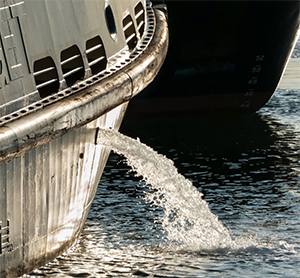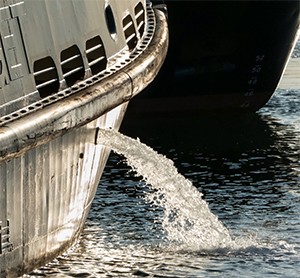(WASHINGTON) — On Oct. 26 in the Federal Register, the Environmental Protection Agency (EPA) published proposed vessel discharge regulations. The new regulations are being implemented pursuant to the Vessel Incidental Discharge Act (VIDA) of 2018. The EPA is soliciting public comment on its proposal until Nov. 25. To view a copy of the Federal Register notice, click here.
Refresher on VIDA
As a reminder, VIDA was enacted by Congress in November 2018 to harmonize conflicting federal and state vessel discharge rules. Currently, two federal agencies and 26 states have discharge regulations. VIDA splits federal oversight of vessel discharges between the EPA and the U.S. Coast Guard. The legislation requires that EPA promulgate and establish standards for discharges by the end of 2020. The Coast Guard is responsible for implementation and enforcement and must develop and finalize its regulations by the end of 2022. Until new rules are finalized and enforced, current law will remain in effect. Once the new rules are in place, state laws will no longer be allowed.
Proposed discharge standards
The new regulations largely mirror current EPA regulations established by the agency’s 2013 Vessel General Permit (VGP). While public debate has focused on regulation of ballast water discharges, the rules are actually much broader and address 20 different vessel discharges including items like bilge water, chain lockers, fire protection equipment, desalination, deck runoff, hull coatings, refrigeration systems, etc. The rules apply to vessels greater than 79 feet in length that operate in U.S. waters. The rules do not apply to recreational vessels or military vessels. The EPA estimates that roughly 82,000 vessels will be impacted by the rules, including cruise ships, ferries, barges, tugs, tows, tankers, bulk carriers, containerships and research ships.
Ballast water regulation
The proposed rules continue a number of so-called best management practices for vessel operators to follow. Such management practices are required under current law. These include activities such as regular cleaning of ballast tanks and proper disposal of any sediment, using pumps rather than gravity to drain ballast tanks (pumps tend to kill organisms), maintaining screens on sea chests, not ballasting near coral reefs, and maintaining a ballast water management plan.
With regard to a ballast water discharge standard, the EPA does not believe that science has changed significantly since the agency developed the 2013 VGP. Consequently, it is proposing a similar ballast water discharge standard based on the earlier scientific analysis. The current numeric standard details how many living organisms are allowed per volume of water. It is consistent with standards established by the International Maritime Organization (IMO). Ballast water treatment system manufacturers design equipment to achieve the numeric discharge standard. To date, the Coast Guard has approved more than two dozen treatment systems that meet the current standard. Many oceangoing vessel operators have already installed treatment systems to comply with the current discharge standard.
For vessels subject to the discharge standard that have yet to install equipment, the deadline will be determined by the Coast Guard in its implementing regulations. In the meantime, such vessels are required to continue to conduct ballast water exchange. In the Great Lakes, ballast water exchange and salt water flushing will be continued for oceangoing vessels – even after ballast water management systems have been installed.
Regulation of lakers
The proposed regulations slightly modify the EPA’s approach to regulation of lakers.
Current law does not require Great Lakes vessels (U.S. or Canadian) built before 2009 that trade exclusively in the Great Lakes Seaway system west of Anticosti Island to comply with the discharge standard. Newer vessels must comply and install treatment systems, as must any laker that operates east of Anticosti.
The proposed regulations mirror current law, except the EPA eliminates the requirement on new (post-2009) lakers. In doing so, the EPA argues that vessel design, operating conditions, trade patterns, voyage length and other issues make it difficult for lakers to comply. The EPA suggests that more research be done before any alternative approach is developed for Great Lakes vessels.
Onshore treatment
The EPA evaluated whether onshore treatment of ballast water is a viable option in lieu of shipboard treatment systems. Both Great Lakes ports and the American Association of Port Authorities (AAPA) have opposed the concept of onshore treatment of ballast water discharges.
The EPA agrees that onshore treatment is unworkable due to the geographic configuration of ports, lack of treatment capacity in port communities, lack of shoreside and shipboard transfer equipment, etc.
The EPA notes that due to the extreme cost of pursuing shipboard treatment, or onshore treatment, one or the other approach should be committed to. Clearly, the global maritime industry is well down the path of shipboard treatment and should not change direction now.
Objections from states
VIDA establishes a process by which any governor may object to any of the proposed discharge standards. To do so, a governor must make a case in writing detailing scientific, technical or operational factors that make the proposed standard insufficient. The EPA must respond to any such governor before publishing its final rule.
Special rules for the Great Lakes
VIDA also establishes a process by which Great Lakes governors can request enhanced requirements in the Great Lakes; however, all eight Great Lakes governors would have to agree to any requirements that would force vessel operators to install special equipment.
The proposed rule lays out this process which includes extensive opportunity for public comment and consultations with both the Coast Guard, governors and the Canadian government.
Timing
Although VIDA requires that the EPA finalize its new discharge standard by the end of 2020, this will be a challenge. While the agency has allowed 30 days for public comment, it has allowed governors 60 days to submit objections. The agency will then need time to formulate a response to both and publish a final rule. That is unlikely to happen by Dec. 31.
The upcoming election will impact the outcome. Should President Trump be re-elected, then this rulemaking will be completed sometime during his second term, which would begin Jan. 20, 2021. Should Joe Biden win the election, it is likely that all new regulations in the pipeline (including this one) will be paused and reviewed. It is possible that a Biden EPA may wish to take a different regulatory approach to vessel discharges.
– American Great Lakes Ports Association


